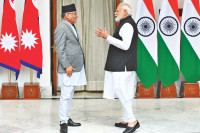Special Supplement
How analog challenges cripple Nepal government’s ambitious ‘Digital Nepal’ vision
Digital Nepal, one of the decorated initiatives of reigning government, is not an entirely new vision in governmental discourse
Kshitiz Khanal
Digital Nepal, one of the decorated initiatives of reigning government, is not an entirely new vision in governmental discourse. The National Information and Communication Technology (ICT) Policy 2015 envisioned Information Communication Technology (ICT) as a key driving force in transforming Nepali society into a knowledge based society, and as a lever in strengthening the pursuit of equality and sustainable growth in order to achieve the overarching vision of ‘Digital Nepal’.
The current government, further aligning this vision with its flagship vision ‘Prosperous Nepal, Happy Nepali’, presented the Digital Nepal Framework at the joint meeting of the National Assembly and House of Representatives on May 21st 2018—essentially providing a roadmap to use digital initiatives for economic growth, solve societal problems and identify opportunities for Nepal. Although the government recognises the potentials of ICT as an enabler of development, the recognition is not satisfactorily reflected in its commitments. In the list of strategic priority sectors of the government from 1 to 5, with 1 indicating highest priority, ICT falls in group 2. The ICT sector was allocated 0.87 billion Nepali Rupees, a mere 0.15 percent of the total annual budget. This makes the promise of Digital Nepal harder and more impractical to achieve, especially if successive annual budgets reflect this proportion.
Status update
The first sign that Nepal has a long way to go to be ‘Digital’ can be found in the fact that digital platforms lack information required to track progresses. It is not easy to find the government’s actual plans in government portals. Even though it is possible to request access to government documents by invoking Right to Information (RTI), it is a lengthy and cumbersome procedure to access information that should be freely and easily available by default. The road to ‘Digital Nepal’ is going to be long and arduous, but it is not for the lack of enthusiasm inside and outside the government.
Adoption of mobile technologies in Nepal, even in her remotest corners, have been very encouraging. Understanding of potential of ICTs to change livelihoods in Nepali populace is only increasing. The enthusiasm of using technology for local development in Nepal’s newly elected local representatives is contagious. Many local governments have mentioned plans towards making their respective places a ‘smart city’ in their annual policies and programs. As per a recent tweet by the secretary of Ministry of Communication and Information Technology (MoCIT), “Mobile app use by local level has reached more than 160, that means more and more local levels are accessible to people.” The bid for Digital Nepal is uncontested at all levels.
More government services, at local and central level are becoming accessible through internet. E-governance services are being increasingly rolled out to different departments and local governments. On April 2018, the government took an important leap forward by making digital payments for government services possible by piloting tax payments using connect IPS—a payment service. But enthusiasm and low hanging fruits can only get us so far.
There lay several challenges on the road to a Digital Nepal. Many of these challenges are traditional (analog) and systemic in nature. They include the lack of demonstrated commitment with an implementation strategy to accompany the vision, capacity deficit in implementing bodies, and lack of supporting government policies in other sectors. For example, limitations put by Nepal Rastra Bank (NRB) in the amount of daily transactions through mobile applications defeat the purpose of using mobile phones for everyday financial transactions. Going digital in financial transactions is not only about using less cash, it also enables NRB to understand flow of money in the economy better.
Aside these traditional challenges, some challenges cannot be understood until they present themselves as impediments. For example, there may be unforeseen hurdles in implementing Digital technologies in unique but diverse Nepali contexts. Impact of technology can be promising, but the journey from potential to impact is a journey into multiple unknowns. Response to introducing digital technologies may be shaped by social, economic, geographical and political dimensions. In our observations, one of the prominent drivers of broadband internet for families living in rural areas is communication with family members who are abroad. Use of social media is common almost everywhere there is mobile network in Nepal, but use of internet for more productive uses is common only in the bigger cities among educated population. The urban-rural divide has given rise to a digital divide.
Overcoming the hurdles
Overcoming most of these challenges strictly fall under the government’s purview. While the government has its work cut out, systemic issues should be addressed first. Policies should be formulated or modified as necessary and implemented so as to: (i) develop technological capacity of implementing bodies and targeted beneficiaries, (ii) disclose government’s specific targets, plans and progress updates proactively, and (iii) support the emerging digital ecosystem.
Cashing on enthusiasm of general public and local government and mobilising digital natives that have entered the workforce inside and outside government can reduce some friction in the process.
The major initiatives aligning with Digital Nepal in pipeline such as the proposed smart cities and e-governance practices should be taken as opportunities to learn the application of digital technologies in the Nepali context. This will help in rolling out other digital technologies at a larger scale and a quicker pace.
Finally, for a country that missed the rising tides of industrialisation and modernisation of agriculture, the opportunities presented by global developments in ICT seem too good to miss. The government needs to demonstrate commitment to fulfill the vision of Digital Nepal, and must be willing to learn from early initiatives. Making all targets specific, updating data on progress regularly, and making such data open would be a good start.
Khanal chairs Open Knowledge Nepal. He tweets @kshitizkhanal7.




 10.12°C Kathmandu
10.12°C Kathmandu










